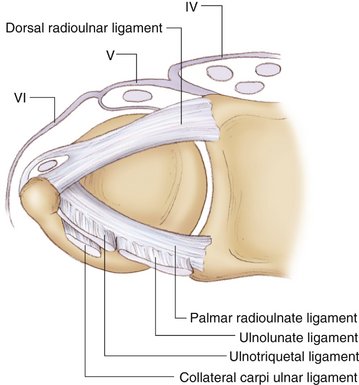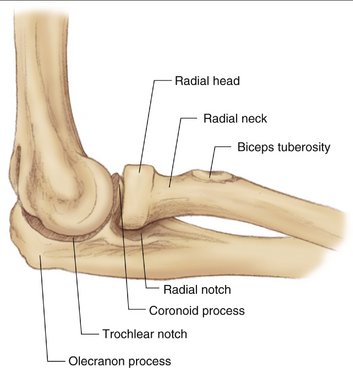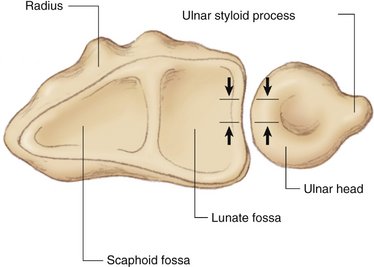CHAPTER 27 Anatomy and Biomechanics of Forearm Rotation
Evolution
Pronation and supination are rotational motions that exist exclusively in the forearm. The mechanical bases for these movements are the existence of two forearm bones and the presence of two coupled trochoid joints—the proximal and distal radioulnar joints (PRUJ and DRUJ).1 Two bones at the forearm are an inheritance from a remote ancestor, the icthyostega, a crossopterygian tetrapod that sprang up from the sea 300 million years ago, transforming its fins into members.2 This unique ability to transfer rotational force to the grasping hand must have played a decisive role in the human evolution.3 Two bones in comparison to one bone with one joint bring advantages—no tendon, nerve, and vessel twisting at the wrist with decreased function. Furthermore, only two bones at the forearm provide a wide range of motion but stable and light construction.4
The DRUJ and PRUJ together work as a single “forearm joint,” resulting in pronation/supination. Hagert5 compared the montages of the forearm with a ventral view of the leg. The proximal ulnar and distal radial segments create a unit similar to the tibia. The olecranon resembles the patella fused with the tuberosity of the tibia; the radial styloid resembles the medial malleolus at the ankle. The proximal radial and distal ulnar segments create a unit reminiscent of the fibula with the ulnar styloid resembling the lateral malleolus.
Anatomy
Distal Radioulnar Joint
The DRUJ consists of two parts: the radioulnar articulation and the ulnoligamentous articulation. The border between these two components is defined as the ulnar extension of a line along the subchondral bone of the distal radius. The articular surface of the distal radius toward the ulnar head is the sigmoid notch, and the corresponding surface of the ulnar head constitutes the seat of the joint.6 The sigmoid notch is a shallow concave articular surface for the ulnar head; it is convex proximally and concave distally, where it meets the lunate facet on its medial surface.7 The radius and ulna are constrained from proximal to distal by the annular ligament, interosseous membrane (IOM), and triangular fibrocartilage (TFC) (Fig. 27-1).7 There is a variation in the relative lengths of the forearm bones, as measured at the wrist. By convention, an ulnar-neutral variance is one in which the distal cortical surface of the ulnar pole is level with the cortical surface of the most proximal aspect of the lunate fossa. This is measured perpendicular to the longitudinal axis of the forearm when the radiograph is taken with the forearm and wrist in neutral extension and neutral deviation and with the x-ray tube perpendicular to the plane of the radiocarpal joint.7 An ulnar-negative variance indicates an ulna that is shorter than the lunate fossa of the radius and an ulnar-positive variance indicates an ulna that is longer. Although most forearms are within 2 mm of a positive variance and 4 mm of a negative variance, pathological conditions are more prevalent at the extremes.8 The shape of the ulnar head depends on the lengths of the ulna and radius. If the ulna is shorter than the radius (ulnar negative), the ulnar head is cone shaped. If the ulna and radius are similar in length, the ulnar head is cylindrical (ulnar neutral). If the ulna is longer than the radius (ulnar positive), the ulnar head is spherical (Fig. 27-2).9,10

FIGURE 27-2 Shaping of the ulnar head depends on the length of the bone and its different anatomical configurations.
Aside from the seat, the ulnar head articulates with the TFC.7 The triangular fibrocartilage complex (TFCC) consists of the dorsal and palmar radioulnar ligaments, the meniscus homologue, and the articular disc. The dorsal radioulnar ligament attaches to the dorsal rim of the distal radius at the level of the sigmoid notch and courses obliquely ulnarly and anteriorly to insert with the palmar radioulnar ligament into the fovea of the ulnar head and the styloid process. The palmar radioulnar ligament attaches radially to the palmar rim of the distal radius at the level of the sigmoid notch and courses obliquely ulnarly and dorsally to attach with the dorsoulnar ligament to the fovea of the ulnar head and the ulnar styloid process (Fig. 27-3).11
Interosseous Membrane
The IOM is a quadrangular sheath that extends from the radius to the ulna, filling the interosseous space. It links both bones of the forearm and also separates the anterior and the posterior compartments of the forearm. Proximally and distally the membrane is not continuous and is perforated by posterior and anterior interosseous vessels (Fig. 27-4).1
Fibers in the anterior plane run distally and obliquely from the medial border of the radius to the lateral border of the ulna. Three bundles are distinguished: the proximal descending fibers are almost horizontal, the intermediate descending fibers follow a short oblique direction, and the distal descending fibers have a long, oblique trajectory.1 In the posterior plane, fibers run proximally and obliquely from the radius to the ulna. The proximal ascending bundle is short, oblique, and quite strong. It arises from the interosseous tubercle of the radius and ends at the proximal ulna. The distal ascending bundle is inconstant. Its direction is long oblique. It arises from the distal radius and reaches the proximal ulna.1 Hotchkiss and coworkers studied the role of the IOM in preventing proximal migration of the radius. In their cadaver study, they found a discrete central band or thickening.12 The central band was responsible for 71% of the longitudinal stiffness of the forearm, whereas the TFCC was responsible for only 8%.
From the IOM of the forearm a tract extends to the dorsal capsule of the DRUJ. It originates from the radius 22 mm proximal to the distal dorsal corner of the sigmoid notch and inserts distally at the capsule of the DRUJ between the tendon sheaths of the extensor digiti minimi and extensor carpi ulnaris. The tract of the IOM is taut in pronation and loose in supination. It strengthens the dorsal capsule of the DRUJ, forming a sling that protects the ulnar head during pronation.13
Proximal Radioulnar Joint
The PRUJ is not a “hinge” but rather a ball-and-socket type of articulation.5 The radial head has a 360-degree convex articulating surface. The head is ovoid rather than circular and is offset approximately 15 degrees from the longitudinal axis of the radius. Cartilage covers 240 degrees of the radial head, which articulates with the ulna at the PRUJ.
The stability of the PRUJ is excellent because the radial head is enclosed in a very strong osteoligamentous cavity that is made of the radial notch of the ulna and the annular ligament, which is a very resistant ligament (Fig. 27-5). There are rarely problems with the joint, except in fractures of the radial head.4
Biomechanics
Kinetics
The ulnar head moves in a rolling and sliding motion from the dorsal to the palmar rim of the sigmoid notch as the joint moves from pronation to supination.7 From pronation to supination, the TFC is taut first dorsally and then palmarly in the same sequence.7 The radius rotates around the ulnar head about a longitudinal axis that passes roughly through the center of the radial head at the PRUJ at the elbow to the fovea of the ulnar head at the level of the wrist (Fig. 27-6).7 The axes of the two radioulnar joints must be aligned coaxially; if not, forearm rotation is blocked. Kapandji compared this situation with a door where two hinges of the door are not aligned; thus, the door cannot be opened.4
The ulnar variance depends on the length of both forearm bones (see earlier), as well as gripping and forearm rotation. The radius migrates proximally with forearm pronation, which increases ulnar variance.14 Maximal ulnar variance is found when gripping with the forearm in pronation; minimal ulnar variance occurs when the hand is relaxed and the forearm is in supination.15 In the pronated position the radius becomes shorter than the ulna and the inferior aspect of the ulna head moves palmarward with regard to the lower rim of the radial sigmoid notch. When there is loss of radial height after a distal radius fracture, resulting in an ulnar-positive variance, pronation increases the impaction to the carpus, particularly the lunate and triquetrum.4
Rotation of the forearm allows the palm of the hand to be directed facing upward, medially, and downward while the elbow is flexed and anteriorly, medially, and posteriorly with an extended elbow. The total arc of rotation is close to 180 degrees. Rotation of the forearm associated with rotation of the shoulder allows for 270 degrees of rotation of the upper limb.1 Because the seat of the ulna fills the sigmoid notch of the radius only in a sector of 90 to 135 degrees, increasing pronation and supination gradually diminishes the contact area. In maximal pronation or supination, the joint surfaces of the seat and sigmoid notch have a marginal contact of 2 to 3 mm.6 Joint surface contact is optimal only in a neutral forearm position (Fig. 27-7).
The ulna and radius transmit loading forces to the elbow and wrist, respectively. Eighteen percent of the load that is transmitted through the wrist passes through the ulna and 82% passes through the radius.16 With the elbow extended, 60% of the load is transmitted through the radius and 40% through the ulna.1 The force transmission through the wrist was investigated by Schuind and associates, who found that the force transmission ratio at the radioulnocarpal joint was 55% through the radioscaphoid and 35% through the radiolunate joints. The remaining 10% of the load passed through the TFC.17
Stability is provided by the contour of the joints, the surrounding ligaments, and the crossing muscles.18













